레이저 3D 스캐닝이란?
레이저 3D 스캐닝은 객체와 환경의 매우 세밀한 3D 모델을 생성하는 최첨단 기술입니다. 이 글에서는 레이저 스캐닝의 작동 방식, 현재 시중에 나와 있는 레이저 스캐너의 종류, 용도 및 이점에 대해 설명합니다.
3D 스캐너, 카메라, 사진 측량 소프트웨어, 심지어 LiDAR 센서가 내장된 스마트폰 등 물리적 물체를 디지털 영역으로 가져올 수 있는 방법이 다양한 오늘날, 선택할 수 있는 옵션의 바다를 항해하는 것은 벅찬 일이 될 수 있습니다. 이 글에서는 가장 널리 사용되는 스캐닝 기술 중 하나인 레이저 3D 스캐닝에 대해 자세히 살펴봅니다.
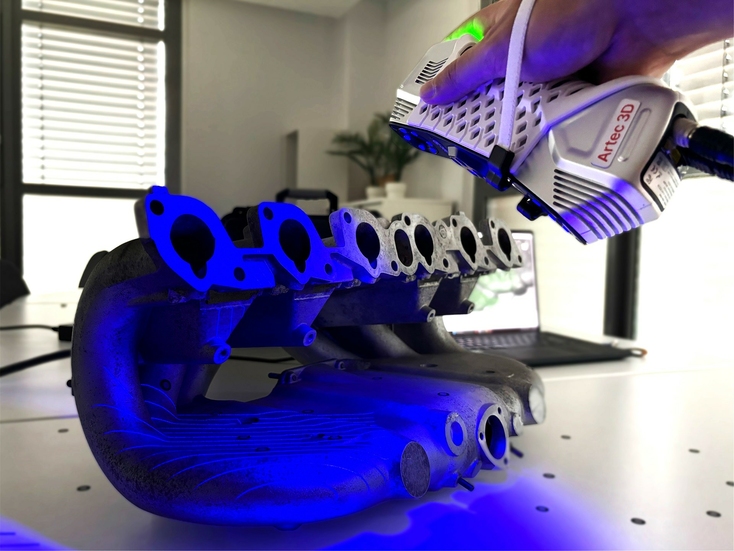
레이저 3D 스캐닝이란?
간단히 말해서 레이저 3D 스캐닝은 레이저를 광원으로 사용하여 모든 객체나 환경에서 정확한 3D 정보를 캡처하는 프로세스입니다. 즉, 이 기술은 레이저 빔을 사용하여 표면까지의 거리를 측정하고 객체, 부지 또는 풍경의 매우 사실적인 3D 모델을 생성합니다. 3D 레이저 스캐닝은 엔지니어링, 건설, 건축 분야에서도 널리 사용되는 도구로, 일반적으로 모든 구조물의 현재 상태를 기록하는 데 사용됩니다.
3D 레이저 스캐너는 LiDAR(빛 감지 및 거리 측정)를 사용하여 레이저 빛을 객체에 투사하여 정확한 위치와 거리를 기록하고 측정합니다. 그 결과 포인트 클라우드 파일을 생성하는 스캐너는 리버스 엔지니어링과 품질 검사부터 문화유산 보존과 법의학에 이르기까지 수많은 분야에서 귀중한 디지털 데이터를 제공합니다. 이 기술은 최신 레이저 스캐너가 휴대가 간편하고 안전하고 사용하기 쉬우며 mm 단위까지 정확하다는 점에서 더욱 널리 사용되고 있습니다.
레이저 3D 스캐닝의 작동 방식은?
레이저 스캐너의 작동 방식은 빛 펄스를 고속으로 방출하여 객체에 반사되어 스캐너의 센서(LiDAR)로 되돌아오는 것으로 요약할 수 있습니다. 각 펄스에 대해 스캐너와 객체 사이의 거리는 전송된 펄스와 수신된 펄스 사이의 경과 시간을 계산하여 측정됩니다. 각 데이터 포인트는 알려진 x, y, z 좌표를 가진 픽셀로 변환됩니다.
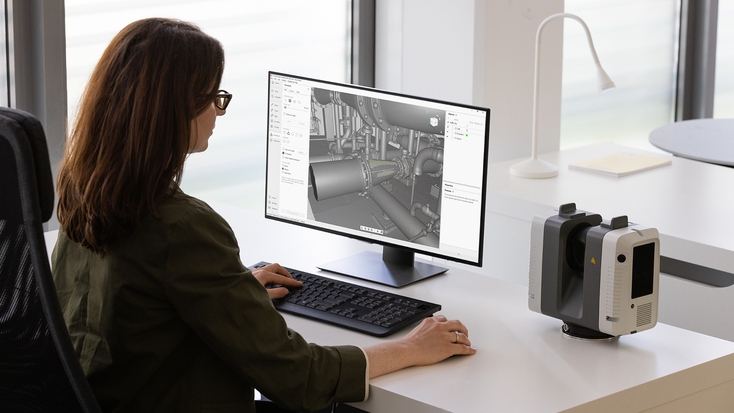
LiDAR 스캐너의 작업 흐름은 다음 단계로 나눌 수 있습니다.
레이저 방출: 스캐너는 일반적으로 사람의 눈에는 보이지 않는 적외선 스펙트럼의 빠르고 짧은 펄스 형태로 객체에 레이저 빔을 투사합니다.
펄스 반사: 레이저 펄스가 객체에 부딪히면 스캐너를 향해 다시 반사됩니다. 객체의 색상, 질감, 반사율과 같은 표면 특성은 레이저 빔이 스캐너로 돌아오는 방식에 영향을 미칩니다.
비행시간 측정: 스캐너는 각 펄스가 장치에서 객체로 이동했다가 다시 돌아오는 데 걸리는 시간을 측정합니다. 그런 다음 이 시간을 빛의 속도를 사용하여 거리로 변환합니다.
포인트 클라우드 생성: 스캐너는 객체 표면의 여러 지점까지의 거리를 계산하여 포인트 클라우드라고 하는 조밀한 데이터 포인트 집합을 생성합니다. 각 포인트는 공간에서 3D 위치를 나타냅니다.
데이터 처리: 포인트 클라우드는 세밀한 3D 모델 또는 지도로 처리되며, 각 포인트는 스캔한 환경을 정확하게 반영합니다. 그런 다음 이 데이터를 시각화하고 분석하여 완벽한 3D 모델을 만드는 데 사용할 수 있습니다.
요점
레이저 3D 스캐닝은 레이저 빛을 객체에 투사하고 반사된 빛을 측정하여 객체의 모양과 치수를 측정하는 방식으로 작동합니다. 수집된 데이터는 세부적인 포인트 클라우드를 형성하고, 이를 3D 모델로 처리하여 분석하고 다양한 애플리케이션에서 사용합니다.
레이저 3D 스캐너의 유형
3D 레이저 스캐너는 다양한 애플리케이션에 맞춰 매우 다양하게 제공됩니다. 스캐너는 휴대용 또는 고정형, 삼각대 장착형 등 독립형 장치에서부터 이동형 또는 공중 레이저 스캐닝 시스템이나 로봇 팔과 같은 복잡한 산업 등급 솔루션에 이르기까지 다양합니다. 레이저 스캐너는 세 가지 유형의 기술 즉, 비행시간, 위상 편이, 삼각 측량을 사용합니다. 각각에 대해 자세히 살펴보겠습니다.
비행시간 시스템 또는 펄스 측정 시스템은 단일 펄스의 레이저 빛을 방출하고 빛이 스캐너의 센서로 반사되는 데 걸리는 시간을 측정하여 끝점까지의 거리를 측정하는 방식으로 작동합니다.
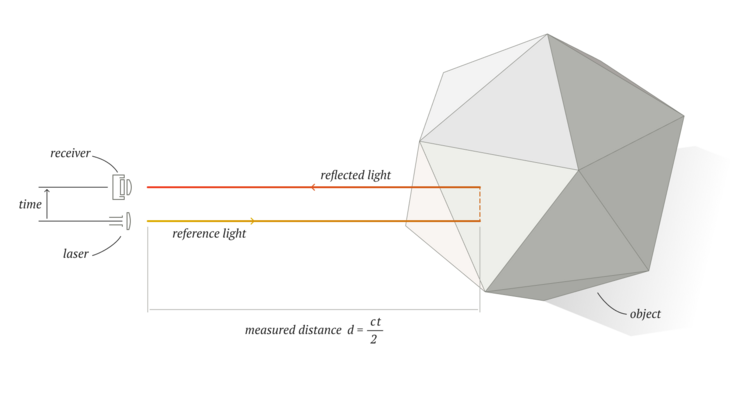
위상 편이 시스템도 방출된 레이저 빛을 사용하지만 빛의 강도는 특정 파형으로 변조됩니다. 강도 패턴의 반사는 객체 표면에 가해지는 충격에 의해 변위됩니다. 전송된 레이저 신호와 수신된 신호 사이의 변위를 측정하면 정확하게 거리를 계산할 수 있습니다.
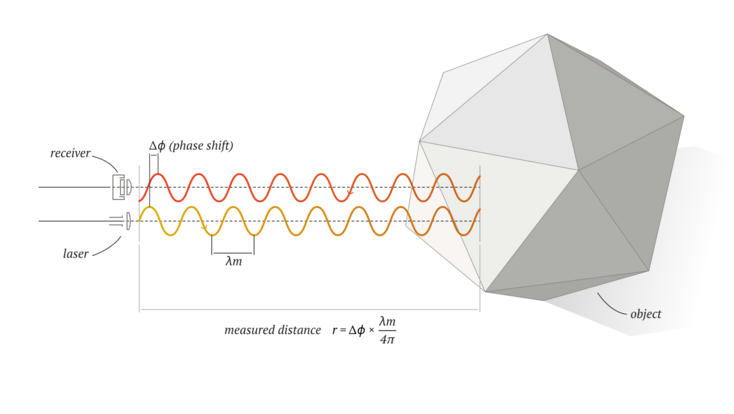
삼각 측량 기반 레이저 스캐너는 레이저 빛을 객체에 방출하고 온보드 카메라 센서로 반사된 빛을 캡처하는 방식으로 작동합니다. 이 시스템은 삼각 측량을 사용하여 레이저 소스, 센서, 객체 표면의 반사된 표적 사이에 삼각형을 형성하여 객체까지의 거리를 계산합니다. 일반적으로 단거리 애플리케이션(5m 미만)에 사용되는 삼각 측량 스캐너는 1cm에서 약 2~3m에 이르는 중소형 객체를 캡처하는 데 탁월합니다.
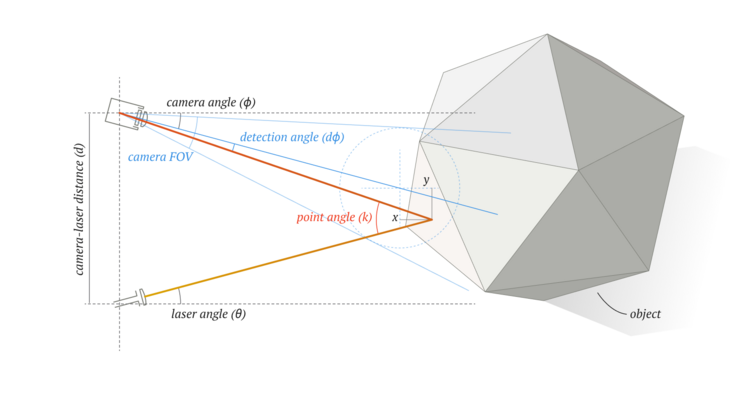
다양한 종류의 물체를 캡처하고 다양한 거리에서 작동하도록 설계된 레이저 스캐너의 대표적인 두 가지 예는 Artec Point와 Artec Ray II입니다. Artec Point는 손바닥 위에서 최대 0.02mm의 정확도를 제공하는 계측 등급의 휴대용 레이저 3D 스캐너인 반면, Artec Ray II는 10m 거리에서 1.9mm의 놀라운 3D 포인트 정확도를 제공하는 장거리 LiDAR 스캐너입니다.
요점
레이저 3D 스캐너는 비행시간, 위상 편이 또는 삼각 측량이라는 세 가지 측정 기술 중 하나를 사용합니다. 비행시간 스캐너는 레이저 펄스가 스캐너로 반사되는 데 걸리는 시간을 계산하는 반면 위상 편이 장치는 변조된 광파 패턴을 비교하여 거리를 측정합니다. 단거리 측정에 이상적인 삼각 측량 스캐너는 삼각법을 사용하여 레이저 소스, 객체, 센서 사이에 삼각형을 형성하여 거리를 측정하므로 중소형 객체를 캡처하는 데 적합합니다.
Artec Point는 휴대용 3D 레이저 스캐너로, 객체와 환경을 빠르고 정확하게 스캔하는 데 적합합니다. Artec의 첫 번째 표적 기반 스캐너는 높은 반복성으로 매우 정확한 3D 데이터를 캡처하므로 산업, 엔지니어링 및 설계 애플리케이션에 없어서는 안 될 필수 요소입니다. 스캐닝 속도가 매우 빨라 초당 최대 280만 개의 측정값을 캡처할 수 있어 빠르고 효율적으로 데이터를 수집할 수 있습니다. Artec Point는 검은색과 광택이 있는 표면을 포함하여 매우 복잡한 표면도 렌더링합니다. 사용자는 그리드, 병렬 및 단일 레이저 모드 중에서 선택하여 결과를 극대화하고 가파른 시야각으로 고정된 HD 카메라를 사용하여 좁은 영역에서 스캔할 수 있습니다.
Artec Ray II는 산업 및 건축 분야에서 대규모 고정밀 스캐닝을 위해 설계되었습니다. 첨단 레이저 기술을 활용하는 Artec Ray II는 탁월한 정확도를 갖추고 있어 풍력 터빈, 보트 프로펠러, 거대한 선박, 교량, 공장 바닥, 법의학 현장 또는 고고학 유적지 등 멀리 있는 거대한 객체를 정밀하게 캡처하는 데 이상적입니다. 리버스 엔지니어링, 품질 검사, 범죄 현장 기록 또는 토목 인프라의 시간 경과에 따른 변화 평가 등 다양한 분야에서 Artec Ray II는 높은 3D 포인트 정확도와 동급 최고의 각도 정확도를 자랑합니다.
레이저 3D 스캐닝의 애플리케이션
레이저 스캐닝 기술은 세부적인 공간 데이터를 캡처할 때 탁월한 정밀도, 속도, 다용도성을 제공함으로써 여러 산업 분야에 혁신을 가져왔습니다. 이 기술은 건설 및 건축에서부터 문화유산 보존 및 제조에 이르기까지 다양한 분야에서 중요한 역할을 해왔습니다. 놀랍도록 정확한 3D 데이터를 캡처하는 레이저 3D 스캐닝은 다양한 분야의 전문가가 설계 충돌을 최소화하고 제조, 개보수 공사, 유지보수 및 연구를 위해 정확한 디지털화를 구현하여 작업 흐름을 개선하는 데 도움을 줍니다. 매우 세밀한 디지털 모델을 생성할 수 있는 레이저 스캐닝은 스마트한 계획, 향상된 협업, 위험 감소를 가능하게 하여 많은 프로젝트에서 필수적인 도구가 되었습니다.
주요 레이저 스캐닝 애플리케이션은 다음과 같습니다.
리버스 엔지니어링
3D 레이저 스캐닝은 객체의 형상을 캡처하여 리버스 엔지니어링에서 핵심적인 역할을 하며, 이를 복제하거나 수정할 수 있습니다. 예를 들어, 기계나 차량의 고유 부품이나 단종된 부품을 재생산해야 하는 경우 레이저 스캐닝을 통해 원래 부품의 매우 정확한 3D 모델을 생성할 수 있습니다. 그런 다음 이 모델을 사용하여 허용 오차가 작은 교체용 부품을 제조할 수 있으므로 오류를 최소화하고 수동 측정의 필요성을 없애며 최종 제품이 제자리에 완벽하게 들어맞도록 할 수 있습니다.
예를 들어, 네덜란드의 한 고속 보트 제작업체는 대형 전문 수제 보트 설계를 재현했습니다. 이 팀은 세 개의 거대한 선박을 스캔하여 리버스 엔지니어링을 할 수 있는 정밀한 3D 모델을 만들어 전문 보트 제작을 용이하게 하고 뛰어난 정확도를 확보했습니다.
품질 검사
레이저 스캐닝은 품질 관리 및 검사 작업 흐름에서 매우 중요합니다. 예를 들어, 고해상도 포인트 클라우드를 생성하여 구조적 무결성, 정렬 및 표면 상태를 평가하여 교량과 홍수 방벽을 검사하는 데 일반적으로 사용됩니다. 엔지니어는 이 데이터를 통해 시간 경과에 따른 변형을 식별 및 모니터링하고 설계 사양을 준수하여 안전 및 유지보수 계획을 강화할 수 있습니다.
GoMeasure3D는 프로젝트 중 하나에서 가동 중인 고가도로 아래에 있는 3.28마일 길이의 홍수 방벽의 손상 여부를 검사할 수 있는 정량화 방법을 찾았습니다. 엔지니어는 Artec Ray II로 거대한 구조물의 일부를 정확하게 캡처하여 변형을 감지하고 부식을 측정하며 유지보수 필요성을 평가하는 데 적합한 높은 세밀도를 구현했습니다.
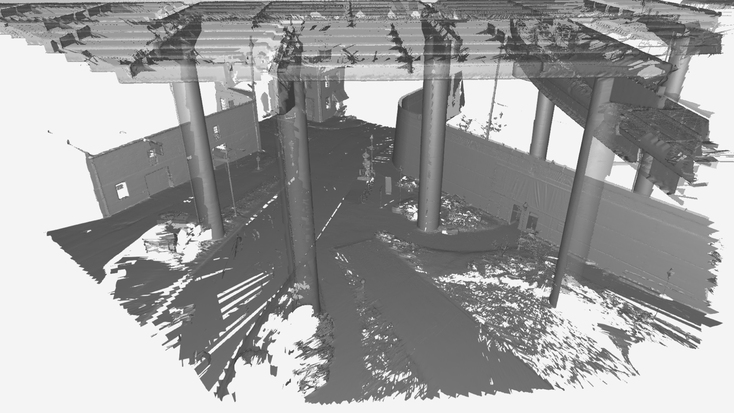
건설
이 기술은 시설의 준공 상태를 기록하고 시간에 따른 변화를 기록하는 데 중요한 역할을 합니다. 건축, 구조, MEP(기계, 전기, 배관) 요소와 같은 매우 복잡한 세부 사항을 캡처합니다. 예를 들어, 시설을 보수할 때 3D 레이저 스캐닝은 현재 구조 프레임워크, 장비 및 배관에 대한 정확한 데이터를 제공할 수 있습니다. 이 데이터를 통해 엔지니어와 건축가는 새로운 설계를 원활하게 통합하여 기존 구조물과 제안된 구조 개선 사항 간의 불일치를 방지할 수 있습니다. 이 기술의 정밀도는 포인트 클라우드가 2~4mm까지 정확하기 때문에 개보수 공사가 정확한 사양에 맞게 이루어지며, 잠재적인 문제를 조기에 파악하고 프로젝트를 신속하게 실행할 수 있습니다.
건축 설계
3D 레이저 스캐닝은 건물의 모든 요소에 대한 정밀한 3D 공간 정보를 제공하여 건축 설계를 간소화합니다. 시설을 재설계할 때 레이저 스캐닝을 사용하여 벽과 창문부터 HVAC 시스템에 이르기까지 눈에 보이는 특징이 있는 모든 공간을 정확하게 3D로 표현합니다. 이 데이터를 통해 건축가는 필요한 모든 측정값을 확보할 수 있습니다. 또한 3D 스캔은 시설의 모든 부분이 설계 계획서와 일치하는지 확인하기에 충분한 수준의 세부 정보를 제공합니다.
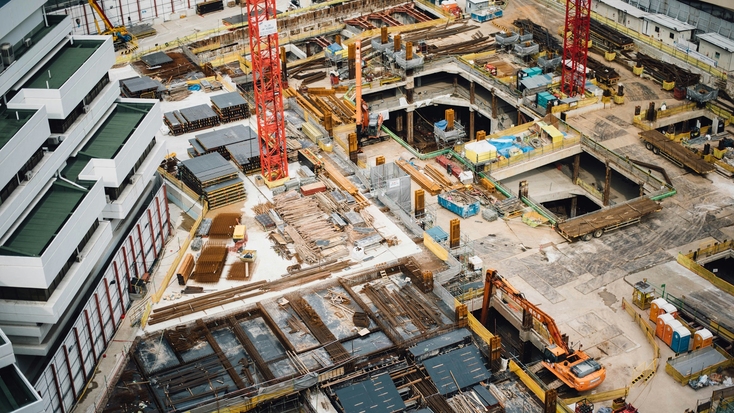
문화유산 보존
문화유산 보존 전문가는 레이저 3D 스캐닝을 비침습적이고 매우 정확한 방법으로 사용하여 문화유산을 기록하고 보호합니다. 고대 건물, 기념물 또는 고고학 유적지를 3D로 보존할 때 레이저 스캐닝은 모든 객체의 미세한 세부 정보를 캡처하여 복원, 보존 및 가상현실 투어를 위한 디지털 트윈을 생성합니다. 이를 통해 우리는 역사와 문화를 보호하는 동시에 미래 세대가 이러한 보물을 자세히 탐구하고 연구할 수 있게 할 수 있습니다.
그 방법에 대한 놀라운 예로 네덜란드의 하가교회(Hagha Church)의 이야기를 들 수 있습니다. 개보수 공사 중 작업자들은 교회의 낡은 나무 바닥 아래에서 묘비들을 발견했습니다. 개보수의 주된 목표는 건물을 보강하기 위해 바닥을 교체하는 것이었지만, 팀은 새로 발견한 문화유산을 지역 주민들이 계속 접할 수 있도록 했습니다. 이 작업은 장거리 3D 레이저 스캐너를 사용하여 숨겨진 보물을 포함한 교회 전체를 캡처함으로써 가능했습니다.
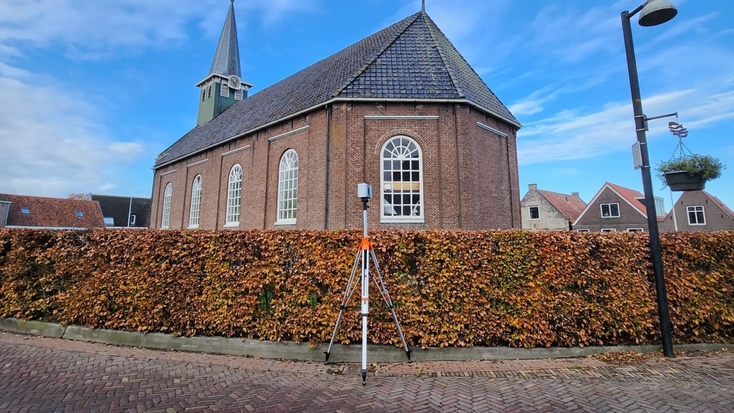
발전소 유지보수 및 개조
보일러, 터빈, 배관 등 기존 인프라에 대한 정확한 기록이 중요한 발전소 개조 작업의 경우 레이저 3D 스캐닝이 필수적입니다. 예를 들어, 노후화된 발전소를 새로운 환경 표준에 맞게 업데이트할 때 이 기술은 발전소 인프라의 포괄적인 3D 모델을 생성합니다. 그런 다음 이 모델을 통해 엔지니어는 업그레이드를 계획하고 구현하여 새 장비가 기존 배치에 원활하게 맞도록 할 수 있습니다. 또한 위험 구역에 대한 가상 점검이 가능하므로 안전 위험을 줄일 수 있습니다. 또한 마모되기 쉬운 구성 요소를 식별할 수 있어 사전 예방적 유지보수 일정을 수립하고 중요 자산의 수명을 연장하는 데 도움이 됩니다.
제조 시설 개조
제조업에서는 공장을 개조하거나 확장할 때 세부적이고 정확한 준공 데이터가 필요하며, 3D 레이저 스캐닝은 장비, 구조물, 공정에 대한 정확한 정보를 제공합니다. 예를 들어, 자동차 제조 공장에서 조립 라인을 업그레이드해야 하는 경우 레이저 스캐닝은 새로운 기계가 이용 가능한 공간에 완벽하게 들어맞도록 하는 데 도움이 됩니다. 3D 데이터를 사용하여 설치를 계획하고 모든 구성 요소가 원활하게 통합되도록 하여 비용이 많이 드는 설치 오류나 지연의 가능성을 줄일 수 있습니다.

법의학
법의학 조사에서 3D 레이저 스캐닝은 전문가가 철저한 분석을 위해 세부적인 범죄 현장이나 사고 현장을 안전하게 캡처해야 할 때 사용됩니다. 예를 들어, 교통사고의 경우 레이저 스캐닝을 통해 차량 위치, 도로 표시, 조명 및 가시성과 같은 환경 요인을 포함한 사고 현장의 정확한 3D 모델을 생성할 수 있습니다. 그런 다음 이러한 디지털 증거는 사건을 재구성하고, 법적 절차를 지원하며, 사고 재구성 전문가가 사고 경위를 파악하는 데 중요한 세부 정보를 제공하는 데 사용될 수 있습니다.
이 애플리케이션의 또 다른 예는 법의 인류학입니다. 머시허스트 대학교(Mercyhurst University)의 한 전문 자격 인증 교수는 3D 스캐닝을 통해 수백 개의 뼈를 디지털화하고 해부학적으로 이를 정밀한 3D 모형으로 변환하여 획기적인 VR 과정을 개설했습니다.
요점
레이저 3D 스캐닝은 특정 전문 작업에 정확한 실시간 데이터를 제공하여 다양한 산업 분야에 혁신을 일으키고 있습니다. 건축 설계를 개선하는 것부터 공장 개조를 용이하게 하고 법의학 수사에 도움을 주는 것까지, 이 기술의 적용 범위는 광범위하며 계속 더 넓어지고 있습니다.
레이저 3D 스캐닝의 이점
3D 레이저 스캐닝은 매우 상세하고 정확한 3D 데이터를 캡처하는 기능으로 인해 여러 산업 분야에서 없어서는 안 될 도구임이 입증되었습니다. 아래에서 3D 레이저 스캐닝의 몇 가지 주요 이점을 확인할 수 있습니다.
높고 반복 가능한 정확도
레이저 스캐닝은 놀라울 정도로 정확하게 측정할 수 있어 리버스 엔지니어링, 품질 검사, 건설 및 제조와 같이 계측 등급의 데이터가 중요한 분야에 효과적입니다.
빠른 데이터 캡처
레이저 스캐너는 안정적으로 추적하면서 방대한 양의 데이터를 빠르게 수집합니다. 수동 측정에 비해 원거리에서 넓은 표면을 3D 스캔하면 현장 직원이 더 빠르고 안전하게 작업할 수 있습니다.
비용 효율적인 솔루션
레이저 3D 스캐닝은 한 번의 스캔으로 데이터를 빠르게 캡처하므로 측정 오류로 인해 비용이 많이 드는 개조와 지연을 방지할 수 있습니다. 이 기술은 CAD 및 BIM 소프트웨어에 원활하게 통합되어 리소스를 절약하고 프로젝트 예산을 계획대로 유지하는 데 도움이 됩니다.
유연성 및 다용도성
레이저 스캐닝 기술은 적응력이 뛰어나며 크고 복잡하거나 접근하기 어려운 물체와 영역에서 데이터를 캡처할 수 있습니다. 실내와 실외는 물론 열악한 환경에서도 사용할 수 있어 전문가가 다양한 규모의 과제를 해결할 수 있습니다.
설계 및 기록 개선
3D 레이저 스캐닝으로 생성된 포인트 클라우드는 매우 사실적인 3D 모델의 기초를 형성하여 사양에 맞게 설계를 개발하고 오류 위험을 최소화할 수 있습니다. 향상된 기록은 또한 팀 간의 협업을 촉진하여 전문가가 프로젝트를 더욱 효과적으로 시각화, 계획 및 모니터링할 수 있게 해 줍니다.
레이저 3D 스캐닝의 잠재적 과제
레이저 3D 스캐닝 기술은 다양한 산업 분야에서 엄청난 이점을 제공하지만 고려해야 할 몇 가지 잠재적 과제가 있습니다. 주요 장애물은 비용으로, 고품질 레이저 스캐닝 장비를 구입하려면 상당한 투자가 필요한 경우가 많습니다. 다행히도, 이러한 과제는 고사양 스캐너와 관련된 뛰어난 품질을 제공하면서도 비용 효율적인 솔루션을 선택함으로써 완화할 수 있습니다.
특히 복잡한 모델의 경우 3D 스캔 데이터를 처리하고 분석하는 소프트웨어도 현명하게 선택해야 합니다. 예를 들어, Artec Studio 19는 3D 스캐너의 잠재력을 극대화하는 고급 기능이 가득한 스마트하면서도 직관적인 3D 스캐닝 및 처리 소프트웨어입니다.. 예산이 부족한 소기업이나 프로젝트에서는 유지보수, 교육 및 라이선스 비용이 부담스러울 수 있지만 우수한 3D 데이터 품질과 일관되게 정확한 결과와 같은 장기적인 이점이 있어 투자할 만한 가치가 있습니다.
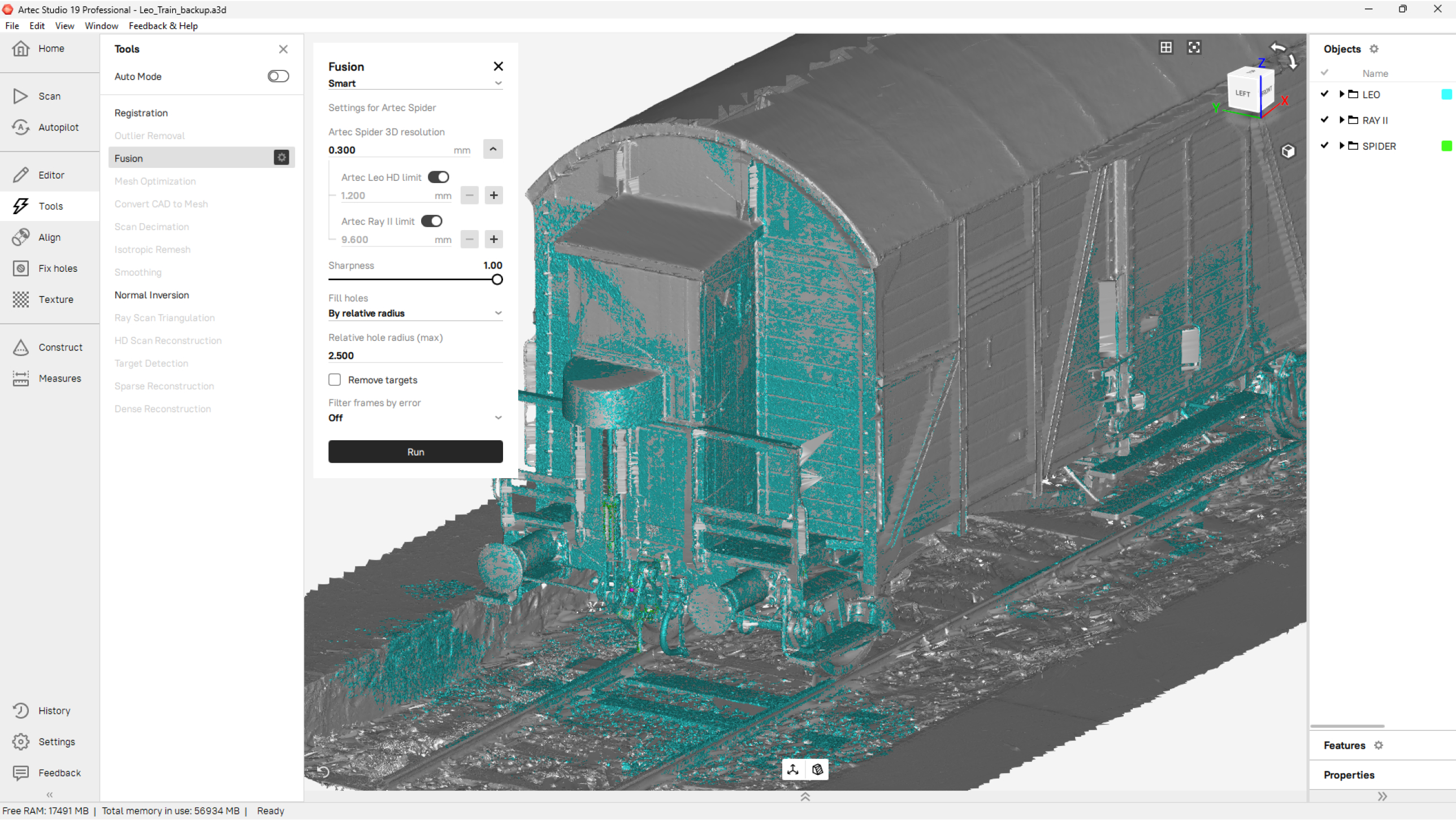
레이저 스캐닝의 또 다른 과제는 대규모 데이터 세트를 관리하는 데 있습니다. 3D 스캐너로 생성된 클라우드는 수백만 개 또는 수십억 개의 데이터 포인트로 구성될 수 있습니다. 방대한 파일은 저장, 처리, 관리가 어려울 수 있으며, 종종 강력한 소프트웨어와 고성능 컴퓨팅 시스템이 필요합니다. 특히 대형 구조물이나 환경의 세부적인 스캔으로 작업하면 작업 흐름이 느려지고 프로젝트 타임라인이 길어질 수 있습니다. 원시 포인트 클라우드를 CAD 도면이나 BIM 모델과 같은 사용 가능한 출력물로 변환하는 작업에도 시간이 많이 걸릴 수 있습니다. 그러나 Artec Studio 19와 같은 도구는 이 프로세스도 단순화합니다. 방대한 데이터 세트를 처리하도록 설계된 이 소프트웨어는 3D 모델링, 리버스 엔지니어링, 품질 검사와 같은 애플리케이션을 훨씬 더 효율적이고 손쉽게 수행할 수 있게 해 줍니다.
주변 조건도 고려해야 합니다. 스캔의 정확도는 조명, 표면 반사율 및 재료 특성의 영향을 받을 수 있습니다. 예를 들어 유리나 거울처럼 반사율이 높은 표면이나 매우 어두운 표면은 데이터 캡처를 복잡하게 만들어 간극이 있는 부정확한 스캔을 초래할 수 있습니다. 이러한 이유로 올바른 스캐너, 특히 열악한 조명 조건이나 까다로운 표면에서도 데이터를 캡처할 수 있는 스캐너를 사용하는 것이 필수적입니다. Artec 3D 레이저 스캐너는 이러한 상황에서 탁월한 성능을 발휘하여 최고 품질의 결과를 만들어냅니다. 또한 Artec 레이저 스캐닝을 배우는 데는 많은 교육이 필요하지 않습니다. 하드웨어와 소프트웨어 모두 사용자 친화적이며 학습 곡선이 비교적 완만합니다. 초보자도 2시간 이내에 능숙하게 정확한 데이터를 수집하고 결과를 해석할 수 있습니다. Artec의 직관적인 기술은 데이터 오류 및 잘못된 해석 위험을 최소화하므로 엔지니어링 전문 지식의 수준이 다양한 사용자들이 기술의 이점을 충분히 활용할 수 있습니다.
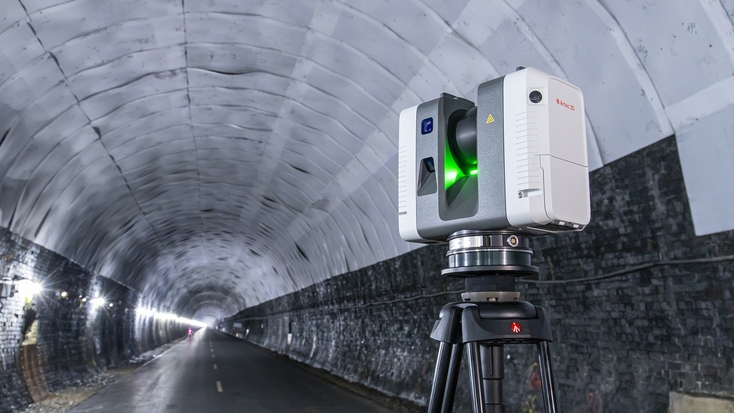
레이저 3D 스캐닝의 미래
앞으로 3D 레이저 스캐닝은 엔지니어링, 건설, 제조, 보존과 같은 산업을 혁신적으로 변화시킬 것입니다. 이 기술의 미래를 형성하는 핵심 추세는 인공지능(AI)과 머신러닝(ML)을 통합하여 포인트 클라우드 처리와 같은 복잡한 작업을 자동화함으로써 수동 입력은 줄이고 효율성은 높이는 것입니다. AI 알고리즘은 실시간 품질 관리를 가능하게 하여 설계 모델과 스캔한 구조물 간의 불일치를 식별하는 반면, ML은 기존 건물의 마모와 파손을 예측할 수 있습니다. 또한 최신 3D 스캐닝 장치의 사용 편의성과 휴대성 덕분에 광업이나 건설과 같은 산업에서 소규모 기업도 데이터 캡처를 더 쉽게 이용할 수 있습니다.
3D 레이저 스캐닝의 진일보한 기술에는 AR 및 VR과의 긴밀한 통합이 포함되어 있어 전문가가 몰입형 방식으로 3D 모델과 상호 작용하여 설계 시각화와 전반적인 의사 결정을 개선할 수 있습니다. 데이터 수집 및 처리 속도가 빨라지면서 3D 스캐닝은 빠르게 진행되는 프로젝트에 점점 더 효율적으로 활용되고 있습니다. 더 나은 센서와 소프트웨어로 스캔 정확도가 향상되면서 항공우주 및 건설과 같은 산업에서 더 엄격한 허용 오차를 구현하고 폐기물을 줄일 수 있게 되었습니다. 전반적으로 향후 몇 년 내에 3D 레이저 스캐닝은 더욱 스마트하고 빠르며 다용도로 활용될 것이며, 데이터 캡처 품질과 애플리케이션 범위가 완전히 새로운 차원으로 발전할 것입니다.
다음으로 이것을 읽으십시오
학습 센터에서
더 자세히 알아보기
3D 스캐닝의 세계에서 시작하는 것은 겁이 날 수 있지만, 잠시 시간을 내어 이면에 있는 기술을 이해하는 순간 모든 것이 명확해집니다. 자신의 눈(원래의 스캐너!)에서 시장에 나와 있는 최신 3D 스캐너에 이르기까지 모든 기능이 다음과 같이 작동합니다.
어떤 물체를 3D 스캔하는 데 드는 비용에 영향을 미치는 많은 요인이 있습니다. 이 안내서에서는 3D 스캐닝 비용에 영향을 미치는 주요 요인을 다루고 자체적으로 스캐너를 구매하는 것이 합당한지 아니면 전문 스캔 대행업체에 맡겨야 하는지 살펴봅니다.
몇몇 세계 최고의 3D 스캐너가 크기와 복잡성에 상관없이 물체를 캡처하는 방법을 정확히 이해하려면 먼저 구조화 광이 작동하는 방식을 면밀히 살펴봐야 합니다. 읽기 쉬운 이 기사에서는 CMM 기계 및 CGI 사진 측량을 비롯한 다른 기술에 비해 구조화 광이 갖는 이점에 대해서도 알아봅니다. 그런 다음 구조화 광 3D 스캐너에 대해 잠재적으로 까다로운 몇 가지 표면을 다룰 것입니다.



